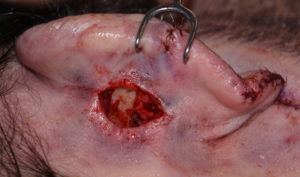The most common form of otoplasty surgery is for the correction of protruding ears. This type of cosmetic ear surgery has been around for more than a century and has evolved to being a primarily cartilage reshaping technique. When setting the ear back, or decreasing the auriculocephalic angle, it is an intraoperative judgement call as to how much to do so. As a general rule it is aesthetically important to keep the outer rim of the ear (helix) in front of the lower level antihelical fold.
But in some cases the ear may get pulled back too far or the helix gets ‘lost’ behind the antihelical rim. This is known as otoplasty overcorrection. Beyond auriculocephalic angles and helical-antihelical structural relationships the satisfying position of the ear is ultimately determined by the patient. If the patient thinks the ear is pulled back to far, then it is.
In early detection of over corrected ears, release of the sutures used to pull it back will be effective. The question becomes how long after the initial procedure can the ear be adjusted. There is no proven time period when this will still work but it is fair to say that six months or later after their placement suture release is not going to move the ear back out. At this point the cartilage has probably lost its memory.

Most otoplasty overcorrection surgeries usually only require 2 to 4mms of helical outer repositioning. Patients are not usually interested in a complete reversal as there is a reason they had the surgery initially. But just a ‘little push out’ is almost always what is needed.
Dr. Barry Eppley
Indianapolis, Indiana


